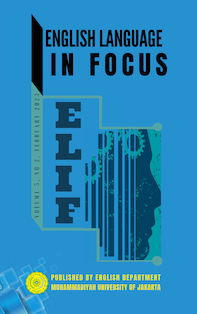The Use of Interactive Powerpoint Media in Improving Student Learning Outcomes of MI Muhammadiyah Poso on Prayer Material
DOI:
https://doi.org/10.24853/elif.5.2.189-196Keywords:
Media, PowerPoint, learning outcomes, PrayersAbstract
AbstrakMedia adalah sebagai alat bantu dalam proses belajar mengajar. Keadaan siswa yang pada umumnya diajar dengan model pembelajaran secara langsung khususnya dengan menggunakan metode ceramah, menunjukkan bahwa siswa kurang bersemangat dalam menerima pelajaran, sehingga mengakibatkan pencapaian hasil belajar siswa yang kurang dari standar KKM. Penelitian ini bertujuan untuk mengetahui perbedaan peningkatan hasil belajar siswa MI. Muhammadiyah Poso dalam pembelajaran. Metode yang digunakan dalam penelitian ini adalah kualitatif. Populasi penelitian ini adalah siswa kelas III a dan kelas III b dengan sampel masing-masing kelas berjumlah 15 orang. Teknik pengumpulan data yang digunakan yaitu teknik observasi dan tes. Hasil penelitian yang didapat adalah 1) terdapat peningkatan hasil belajar pada kelas IIIa dan IIIb, 2) terdapat peningkatan minat dan pemahaman selama proses pembelajaran berlangsung, dan 3) Terdapat perbedaan hasil belajar sebelum menggunakan media dengan sesudah menggunakan media. Disimpulkan dengan adanya media yang digunakan dalam pembelajaran, maka hasil belajar siswa pun mengalami peningkatan. Kata Kunci: Media, PowerPoint, hasil belajar, Sholat. AbstractMedia is a tool in the teaching and learning process. The condition of students who are generally taught by direct learning models, especially by using the lecture method, shows that students are less enthusiastic about receiving lessons, resulting in achievement of student learning outcomes that are less than the KKM standard. This study aims to determine differences in the improvement of MI students' learning outcomes. Muhammadiyah Poso in learning. The method used in this research is qualitative. The population of this study were students of class III a and class III b with a sample of 15 people from each class. Data collection techniques used are observation and test techniques. The research results obtained were 1) there was an increase in learning outcomes in class IIIa and IIIb, 2) there was an increase in interest and understanding during the learning process, and 3) there were differences in learning outcomes before using the media and after using the media. It was concluded that with the media used in learning, student learning outcomes also increased. Keywords: Media, PowerPoint, learning outcomes, Prayers.References
Irwanto. 2020. Implementation of I-Spring Multimedia with Powerpoint to improve Student Learning Outcomes on Learning Prayer for Islamic Religious Education Subjects. Journal of Educational Research, (online), volume 7, number 1, 2020, p. 67 (https://journal.uniku.ac.id/index.php/pedagogi )
Wulandari Carmi. (2020). Application of Prayer Animation Video Media in achieving the Learning Taxonomy. Undergraduate Thesis at the Tarbiah Faculty of the Al-Qur'an Institute of Sciences (IIQ) Jakarta
Hidayah Nurul. (2019). The Effect of Using Power Point Media on Student Learning Outcomes in Islamic Education Learning at SMP Anak Bangsa, Rappocini District, Makassar. Undergraduate Thesis at the Faculty of Teacher Training and Education Universitas Muhammadiyah Makassar.
Mayasari Ika. (2018). The Use of Learning Media (Powerpoint) in Increasing Motivation to Learn Arabic in Grade VIII Students of SMP Unismuh Makassar. Undergraduate Thesis at the Faculty of Islamic Religion Universitas Muhammadiyah Makassar
Damasanti Lucia. Ermawati Zulikhatin Nuroh. (2023). Use of PowerPoint Media in Thematic Learning at SD Muhammadiyah 1 Krian. Journal of Education and Learning Dimensions. Muhammadiyah University of Sidoarjo/January:19-25
Rihani, A. L., Maksum, A., & Nurhasanah, N. 2022. Literature Study: Interactive Media Against Learning Outcomes of Class V Elementary School Students. JKPD (Jurnal Kajian Pendidikan Dasar), 7(2), 123-131.
(https://journal.unismuh.ac.id/index.php/jkpd/article/view/7702)
Jannah, I. N. 2020. The effectiveness of using multimedia in learning science in elementary school. Elementary School Scientific Journal, 4(1), 54-59.
(https://ejournal.undiksha.ac.id/index.php/JISD/article/view/24135)
Riva’ie, W., & Syukri, M. 2015. IMPLEMENTATION OF POWERPOINT MEDIA IN LEARNING SUNAH RAWATIB PRAYERS. Equatorial Journal of Education and Learning (JPPK), 4(6).
(https://jurnal.untan.ac.id/index.php/jpdpb/article/view/10339)
Sulastri, S. 2017. The Effectiveness of Using Power Point Media in Pie Learning at Tunas Dharma Way Galih Middle School, South Lampung Academic Year 2016/2017 ((Doctoral dissertation, IAIN Raden Intan Lampung)).
(http://repository.radenintan.ac.id/474/)
SABTUTI, S. 2021. THE USE OF AUDIO-VISUAL-BASED TEACHING MATERIALS TO IMPROVE STUDENTS' LEARNING OUTCOMES IN CLASS VIII-J IN PABP SUBJECT MATERIALS OF CIRCUIT PRAYERS AT SMPN 1 TASIKMALAYA. EDUTECH: Journal of Technology Assisted Education Innovation, 1(3), 189-196.
(https://www.jurnalp4i.com/index.php/edutech/article/view/654)
Riva’ie, W, & Syukri, M. 2015. IMPLEMENTATION OF POWERPOINT MEDIA IN LEARNING SUNAH RAWATIB PRAYERS. Equatorial Journal of Education and Learning (JPPK), 4(6).
(https://jurnal.untan.ac.id/index.php/jpdpb/article/view/10339)
Published
Issue
Section
License
Authors who publish with this journal agree to the following terms:
- Authors retain copyright and grant the journal right of first publication with the work simultaneously licensed under a Creative Commons Attribution License that allows others to share the work with an acknowledgment of the work's authorship and initial publication in this journal.
- Authors can enter into separate, additional contractual arrangements for the non-exclusive distribution of the journal's published version of the work (e.g., post it to an institutional repository or publish it in a book), with an acknowledgment of its initial publication in this journal.
- Authors are permitted and encouraged to post their work online (e.g., in institutional repositories or on their website) before and during the submission process, as it can lead to productive exchanges, as well as earlier and greater citation of published work (See The Effect of Open Access).


